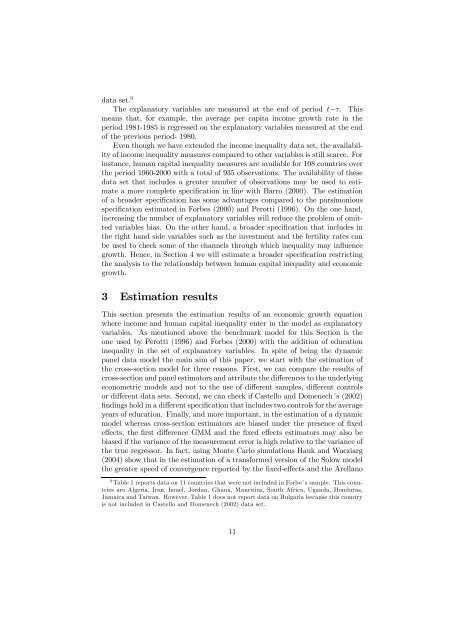Amparo Castelló-Climent, Universidad Carlos III de Madrid ... - Ivie
Create successful ePaper yourself
Turn your PDF publications into a flip-book with our unique Google optimized e-Paper software.
data set. 9<br />
The explanatory variables are measured at the end of period t−τ. This<br />
means that, for example, the average per capita income growth rate in the<br />
period 1981-1985 is regressed on the explanatory variables measured at the end<br />
of the previous period- 1980.<br />
Even though we have exten<strong>de</strong>d the income inequality data set, the availability<br />
of income inequality measures compared to other variables is still scarce. For<br />
instance, human capital inequality measures are available for 108 countries over<br />
the period 1960-2000 with a total of 935 observations. The availability of these<br />
data set that inclu<strong>de</strong>s a greater number of observations may be used to estimate<br />
a more complete specification in line with Barro (2000). The estimation<br />
of a broa<strong>de</strong>r specification has some advantages compared to the parsimonious<br />
specification estimated in Forbes (2000) and Perotti (1996). On the one hand,<br />
increasing the number of explanatory variables will reduce the problem of omitted<br />
variables bias. On the other hand, a broa<strong>de</strong>r specification that inclu<strong>de</strong>s in<br />
the right hand si<strong>de</strong> variables such as the investment and the fertility rates can<br />
be used to check some of the channels through which inequality may influence<br />
growth. Hence, in Section 4 we will estimate a broa<strong>de</strong>r specification restricting<br />
the analysis to the relationship between human capital inequality and economic<br />
growth.<br />
3 Estimation results<br />
This section presents the estimation results of an economic growth equation<br />
where income and human capital inequality enter in the mo<strong>de</strong>l as explanatory<br />
variables. As mentioned above the benchmark mo<strong>de</strong>l for this Section is the<br />
one used by Perotti (1996) and Forbes (2000) with the addition of education<br />
inequality in the set of explanatory variables. In spite of being the dynamic<br />
panel data mo<strong>de</strong>l the main aim of this paper, we start with the estimation of<br />
the cross-section mo<strong>de</strong>l for three reasons. First, we can compare the results of<br />
cross-section and panel estimators and attribute the differences to the un<strong>de</strong>rlying<br />
econometric mo<strong>de</strong>ls and not to the use of different samples, different controls<br />
or different data sets. Second, we can check if Castello and Domenech´s (2002)<br />
findings hold in a different specification that inclu<strong>de</strong>s two controls for the average<br />
years of education. Finally, and more important, in the estimation of a dynamic<br />
mo<strong>de</strong>l whereas cross-section estimators are biased un<strong>de</strong>r the presence of fixed<br />
effects, the first difference GMM and the fixed effects estimators may also be<br />
biased if the variance of the measurement error is high relative to the variance of<br />
the true regressor. In fact, using Monte Carlo simulations Hauk and Wacziarg<br />
(2004) show that in the estimation of a transformed version of the Solow mo<strong>de</strong>l<br />
the greater speed of convergence reported by the fixed-effects and the Arellano<br />
9 Table 1 reports data on 11 countries that were not inclu<strong>de</strong>d in Forbe´s sample. This countries<br />
are Algeria, Iran, Israel, Jordan, Ghana, Mauritius, South Africa, Uganda, Honduras,<br />
Jamaica and Taiwan. However, Table 1 does not report data on Bulgaria because this country<br />
is not inclu<strong>de</strong>d in Castello and Domenech (2002) data set.<br />
11

















